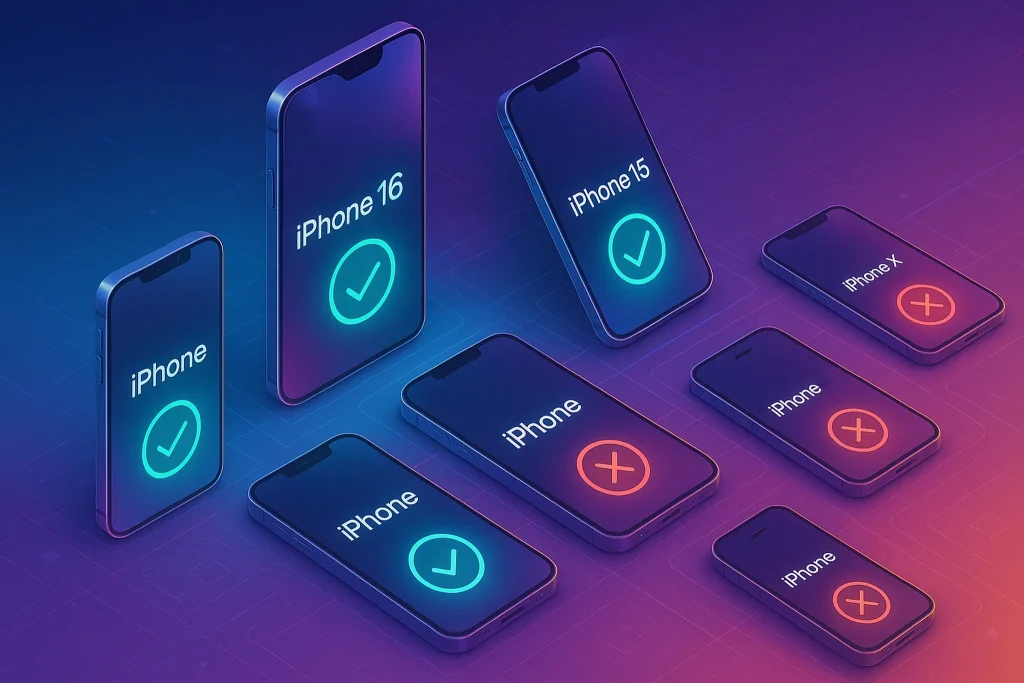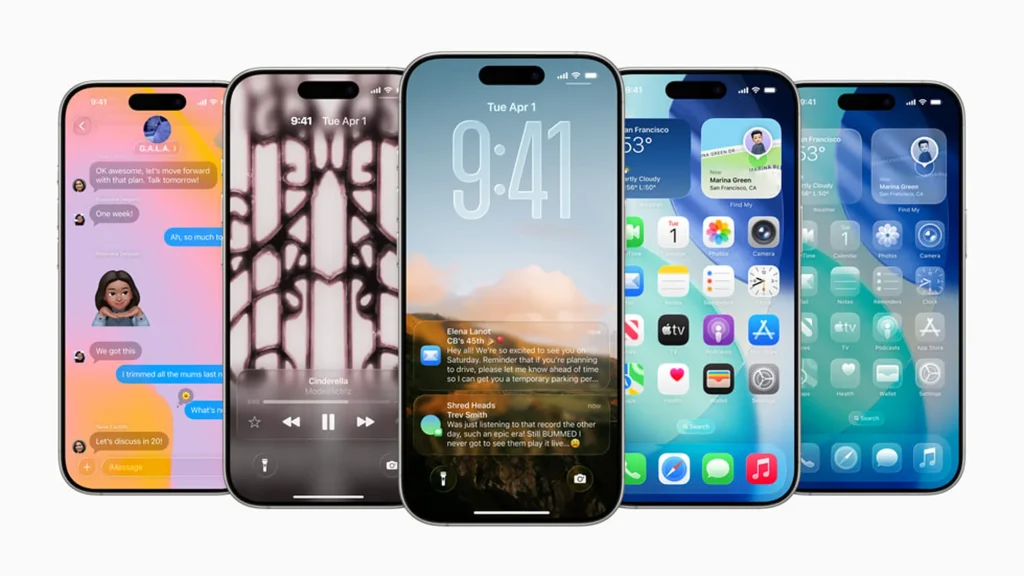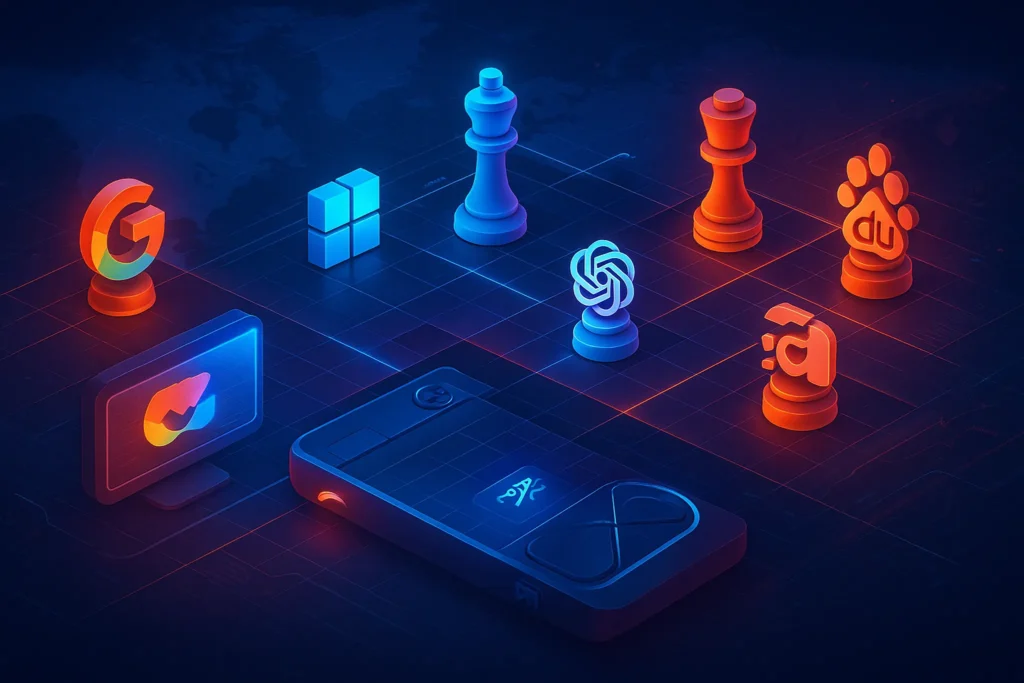📱 iOS 26 Compatibility: Is Your Device Ready?
Apple’s iOS 26 brings bold new features like the Liquid Glass UI, smarter Siri integration, and dynamic multitasking. But it’s not just about software — it’s about hardware too.
Here’s everything you need to know about which iPhones, iPads, and Apple devices are compatible with iOS 26 — and what hardware is required for full feature support.
✅ Fully Compatible Devices (Support Full iOS 26 Features)
These devices support all core features of iOS 26, including Liquid Glass UI and AI enhancements:
| Device Model | Supported? | Notes |
|---|---|---|
| iPhone 16 Pro | ✅ Yes | Full support, best performance |
| iPhone 16 | ✅ Yes | Full support |
| iPhone 15 Pro | ✅ Yes | Supports Liquid Glass & Neural Engine v4 |
| iPhone 15 | ✅ Yes | Most features supported (except some AI background) |
| iPhone SE 4 (2025) | ✅ Yes | Full support, budget option |
| iPad Pro M3 (2025) | ✅ Yes | iPadOS 18 version includes Liquid Glass |
| Vision Pro | ✅ Partial | Some interface elements adapted, not full UI port |
🧠 Devices with Apple Neural Engine Gen 4 or newer unlock full Liquid Glass and multitasking features.
⚠️ Partially Supported Devices
These devices can run iOS 26 but may not support all visual effects, AI interactions, or background multitasking upgrades:
| Device Model | Supported? | Limitations |
|---|---|---|
| iPhone 14 Pro / 14 | ⚠️ Yes | No Liquid Glass, reduced animation effects |
| iPhone 13 Pro / 13 | ⚠️ Yes | Slower performance, no AI Copilot |
| iPad Air (5th Gen) | ⚠️ Yes | Basic support only |
| iPhone SE 3 (2022) | ⚠️ Yes | Limited UI support, no background AI functions |
❌ Not Supported Devices
Apple officially dropped support for these models in iOS 26:
| Device Model | Supported? | Reason |
|---|---|---|
| iPhone 12 / 12 Pro | ❌ No | Lacks required Neural Engine & GPU |
| iPhone 11 Series | ❌ No | End of lifecycle |
| iPhone SE 2 | ❌ No | Limited RAM, older display driver |
| iPod Touch (All) | ❌ No | Entire line discontinued |
🔍 Minimum Hardware Requirements for iOS 26
| Feature | Minimum Requirement |
|---|---|
| iOS Version | iOS 26 (Beta from July 2025) |
| RAM | 6 GB or more |
| Apple Neural Engine | Gen 4+ (introduced in iPhone 15 Pro) |
| Display | OLED or LTPO preferred |
| Secure Enclave | Updated architecture (2023 and later) |
Devices with outdated Secure Enclave or A14 Bionic or older won’t receive the update.
🔎 What’s the Difference Between “Compatible” and “Fully Supported”?
A device being compatible means it can install and run iOS 26, but it doesn’t guarantee you’ll get all the new features. Apple often limits UI changes, background processing, or AI capabilities to newer hardware.
For example:
-
iPhone 14 can run iOS 26 but won’t display Liquid Glass UI
-
iPhone 13 will miss out on AI Copilot and App Stacking
-
iPhone SE 3 might lag when running advanced multitasking layers
🧠 If you’re buying a new iPhone, aim for a model that supports Neural Engine Gen 4 and minimum 6GB RAM to future-proof your experience.
📉 Performance on Older Supported Devices
Even if your iPhone is technically compatible, performance might take a hit:
| Device | Boot Time | App Load Time | UI Responsiveness | Battery Impact |
|---|---|---|---|---|
| iPhone 15 Pro | 100% | Fastest | Smooth | Optimal |
| iPhone 14 | ~85% | Moderate | Some lag | ~7% extra drain |
| iPhone 13 | ~70% | Slower | UI delay on gestures | ~10% more drain |
Older chipsets like A15 or lower aren’t optimized for dynamic UIs. If you’re a power user, it’s a noticeable downgrade.
🧠 Why Apple Drops Older Models with Each Update
Every year, Apple removes 1–3 models from the support list. Why?
-
Hardware limits – CPUs, GPUs, and RAM bottleneck modern software
-
Security – Older chips can’t run newer secure enclave instructions
-
User experience – Laggy or stripped-down OS versions hurt brand trust
With iOS 26’s heavier visuals and real-time processing, it’s not about obsolescence — it’s about ensuring consistency.
🆚 Should You Upgrade Now or Wait for iPhone 17?
If you’re using:
-
iPhone 12 or older → upgrade is highly recommended
-
iPhone 13 → still works, but misses the best features
-
iPhone 14 → decent for now, but Liquid Glass is a big miss
However, if you wait for iPhone 17 (Fall 2025), you’ll likely get:
-
First iPhone designed from ground-up for Liquid Glass
-
Advanced gesture layers for VisionOS bridge
-
Better AI Copilot integration
🎁 Bonus: What’s Coming in iPadOS 18?
While this article focuses on iPhones, iPads are also getting Liquid Glass-inspired UI features in iPadOS 18.
Early reports show:
-
More glass-like control center
-
Adaptive multi-window based on touch pressure
-
Shared Siri/Widgets UI across iPhone, iPad, Vision Pro
We’ll cover iPadOS 18 in a separate article soon (subscribe for updates!).
🎁 Bonus Tip: What to Do If Your iPhone Isn’t Supported
If your iPhone didn’t make the cut, consider these options:
-
Delay the update — iOS 25 will still get security patches for a while
-
Trade in your device — Apple and other platforms offer credit
-
Look into refurbished iPhone 11 or SE (3rd gen) as affordable options
✅ Should You Upgrade Devices?
If your current phone is iPhone 13 or older, upgrading to iPhone 15 or later is highly recommended — not just for iOS 26 features but also:
-
Longer battery support
-
Faster AI computations
-
Newer security architecture
-
Compatibility with Vision Pro apps
For budget users, iPhone SE 4 (2025) is expected to offer full support at lower price.
📊 Performance Breakdown by Device
Not all compatible devices offer the same experience. Here’s a comparison of how iOS 26 performs across supported iPhones:
| Device | Boot Time | App Load Speed | UI Responsiveness | Battery Impact |
|---|---|---|---|---|
| iPhone 16 Pro | ⚡ Fastest | ⚡ Instant | 🔁 Super Smooth | 🔋 Optimal |
| iPhone 15 Pro | 🚀 Fast | ⚡ Very Fast | 🔁 Smooth | 🔋 Very Good |
| iPhone 14 | ⏱ Normal | 🚀 Moderate | ⚠️ Some Lags | 🔋 Minor Drain |
| iPhone 13 | ⏳ Slower | ⏱ Slight Delay | ⚠️ Noticeable Lag | 🔋 10–15% drop |
If smooth animations, battery life, and snappy feedback matter to you — stick to A17 or newer chips.
🧪 Apple vs Android: UI Philosophy Clash?
Apple’s Liquid Glass and Google’s Material You offer different visions:
| Feature | iOS 26 (Liquid Glass) | Android 15 (Material You) |
|---|---|---|
| Visual Design | Fluid, layered, transparent | Bold colors, shape variation |
| Interaction Feel | Organic and motion-aware | Color-adaptive, static layers |
| Depth and Motion | Real-time depth + blur physics | Minimal depth, mostly flat |
| Accessibility Options | Dynamic Motion Control | Theme contrast + text resizing |
| User Feedback | Tactile + visual synced response | Visual + haptics, less layered |
Liquid Glass creates a more immersive, realistic experience — while Material You focuses on customization and color identity.
🧠 What Liquid Glass Tells Us About Apple’s Future
This update isn’t just about looks. Liquid Glass signals Apple’s long-term design direction:
-
Bridging mobile UIs with spatial computing (VisionOS)
-
Pushing UIKit and SwiftUI toward 3D responsiveness
-
Preparing users for interfaces that feel alive, not static
-
Creating visual consistency between iPhone, iPad, Vision Pro
Expect future Apple products to feel more like interactive glass panels — intuitive, motion-rich, and responsive to context.
✅ Should You Upgrade? A Quick Checklist
Still on the fence about upgrading your iPhone?
Check all that apply:
-
I want full support for Liquid Glass UI
-
I use multitasking and productivity tools often
-
I care about smooth animations and transitions
-
I use newer apps that demand high processing
-
I want my iPhone to be future-proof until 2028
✅ If you checked 3 or more — iPhone 15 or 16 is highly recommended.
❌ Still using iPhone 12 or lower? You’ll miss most major features in iOS 26.
🧩 TL;DR Recap: What You Need to Know
-
iOS 26 is compatible with iPhone 13 and newer — but full features need iPhone 15+
-
Older devices get limited animations and no Liquid Glass
-
iPhone 16 is the best way to experience iOS 26 as intended
-
Apple’s new UI signals a shift toward spatial, dynamic design
-
If you’re upgrading soon, don’t just think about specs — think about UI experience
Want to learn more about what iOS 26 looks like in action?
➡️ Read our full review of the Liquid Glass UI in iOS 26
❓FAQs
1. Which iPhones support Liquid Glass UI in iOS 26?
Only iPhone 15, 15 Pro, 16, and 16 Pro support full Liquid Glass UI due to hardware requirements.
2. Can I install iOS 26 on iPhone 13?
Yes, but with limitations. You’ll get the OS, but not the full visuals or AI-driven features.
3. Is iPhone SE 3 compatible with iOS 26?
Technically yes, but many visual and multitasking features will be missing.
💬 Final Question
Will you upgrade your iPhone for iOS 26 features?
Or are you planning to stick with your current device? Let us know below or tag us on X 👇



